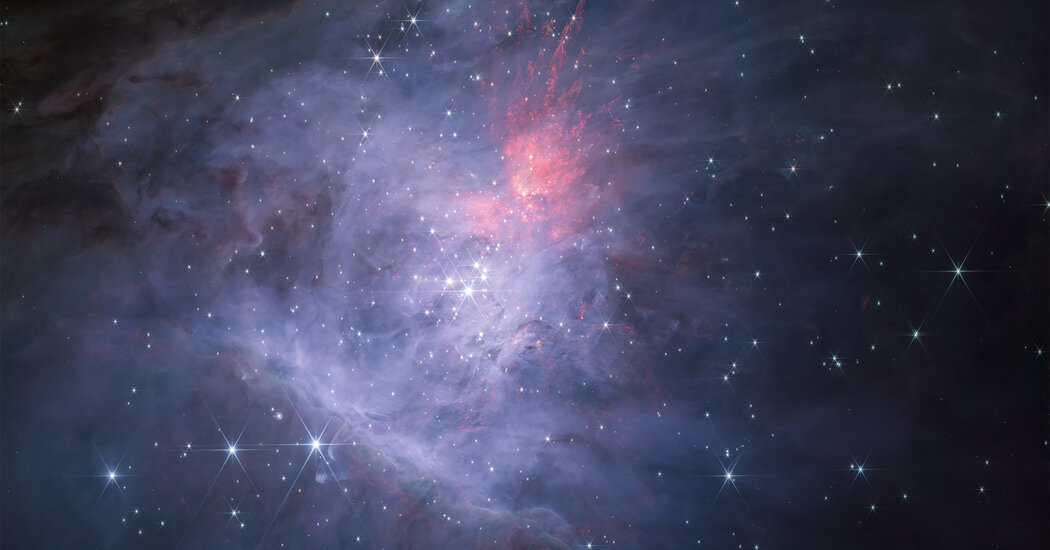We have discovered a lot in this universe. Planets that orbit stars at right angles. Forbidden worlds that have cheated death. Space explosions that defy explanation.
Yet the cosmos continues to surprise us.
The latest spectacle, observed by the James Webb Space Telescope, is an agglomeration of nearly 150 free-floating objects amid the Orion Nebula, not far in mass from Jupiter. Dozens of these worlds are even orbiting each other. The scientists who discovered them have called them Jupiter Mass Binary Objects, or JuMBOs, and the reason for their appearance is a complete mystery.
“There’s something wrong with either our understanding of planet formation, star formation — or both,” said Samuel Pearson, a scientist at the European Space Agency who worked on the observations that were shared on Monday, which have not yet been peer reviewed. “They shouldn’t exist.”
The Orion Nebula is a region of star formation 1,350 light-years from Earth, located in the belt of the northern hemisphere constellation of Orion. It has long been studied by astronomers, but the scientists involved in the new Webb telescope study of the area, also released on Monday, say the new images are “by far” the best views yet.
“We have better than Hubble resolution but now in the infrared,” said Mark McCaughrean, a senior adviser for science and exploration at the ESA. He said the latest observations revealed reams of star formation and fledgling planetary systems in a manner never seen before.
Stars in our universe form when giant clouds of dust and gas gradually coalesce under gravity. Eventually, regions of a cloud become so dense that they squeeze atoms of hydrogen together and kick-start nuclear fusion, forming the core of a star. In less dense areas, a more diminutive version of fusion — deuterium fusion — can occur in smaller objects. These are called brown dwarfs, or sometimes “failed stars.”
JuMBOs appear to be a smaller class of gaseous object. While brown dwarfs can grow to about 13 times the mass of Jupiter, the new objects can get as small as about half the planet’s mass, with temperatures of more than 1,000 degrees Fahrenheit. They are separated by about 200 times the distance between the Earth and the Sun, orbiting each other on paths that take more than 20,000 years to complete.
Were they alone in space, they might be easier to explain. But their appearance in pairs, 42 of which are seen by the Webb telescope in the Orion Nebula, is baffling. According to existing scientific models, it should not be possible to form single objects so small directly from clouds of dust and gas, let alone in pairs, Dr. Pearson said. Even if they were ejected planets — violently kicked from young stars because of gravitational forces — it is similarly unclear why there would be so many couplets.
“It’s like kicking a cup of tea across a room and having all the tea land in the teacup,” Dr. Pearson said. “And then doing that 42 times.”
The discovery is “completely unexpected,” said Matthew Bate, a professor of theoretical astrophysics at the University of Exeter in England. Many stars, perhaps even all stars, including our sun, are born as pairs. But as binary objects decrease in mass, they become less common, as their weaker gravitational attraction makes them more easily torn apart. Yet the existence of JuMBOs “implies we may be missing something about how these very low mass objects form,” Dr. Bate said.
Dr. Pearson hopes to get to the bottom of the problem by using the Webb telescope to pick apart the light from the objects, revealing what their gaseous atmospheres are made of and perhaps how they formed. Currently, he said, he can only deduce evidence of methane and water on them.
Looking for JuMBOs in other star-forming regions could help, too.
“Orion is really massive and really dense,” Dr. Pearson said. “Do we find the same thing happens in a sparse region? That might give us a clue of what formation mechanism might be happening.”
Until that mystery is solved, humans can marvel at the Webb telescope’s valuable new vantage of the Orion Nebula.
“When I was a young student and we were just starting to use electronic sensors on telescopes, we often waited with great anticipation for each ‘YAMOO’ — Yet Another Map Of Orion — because of the remarkable and surprising details each new detector revealed,” said Heidi Hammel, a NASA interdisciplinary scientist for the telescope and vice president for science at the Association of Universities for Research in Astronomy.
The Webb telescope, she said, just “delivered spectacularly on its YAMOO.”











